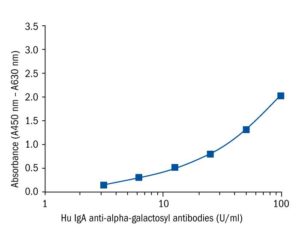Anti-Alpha-Galactosyl IgA Human ELISA
Natural antibodies circulate in serum of healthy humans naturally, without previous immunization. They can be directed against the individual’s own antigens as well as against foreign antigens. The repertoire of natural antibodies is encoded by germ-line genes and is not subjected to recombination. Natural antibodies are polyreactive and react with low affinity but high avidity. Among the natural antibodies directed against saccharide antigens, the best known are:
- isohemagglutinins (anti-A, anti-B) which prevent the transfusion of allogeneic blood and allotransplantation;
- xenoagglutinins (80% of the repertoire of human xenoreactive natural antibodies is specific for the terminal α-galactose determinant) which have traditionally been detected by agglutination test with rabbit or porcine erythrocytes. The epitope against which they are directed was identified as Galα1–3Galβ1–4GlcNAc-R. This epitope is present in cell membranes of mammals with the exception of humans and Old World primates in which the gene encoding for α-1,3-galactosyltransferase was inactivated during evolution. This epitope is also present in lipopolysaccharides and capsular polysaccharides of various gramnegative bacteria colonizing the gastrointestinal tract of humans.
In human serum, natural anti-α-galactosyl antibodies (anti-α-Gal) constitute approximately 4 –8 % of total serum IgM, approx. 1 – 2 % of total serum IgG, and they can also be found as the IgA isotope in serum, saliva, milk, colostrum and vaginal washings. About 1 % of circulating B lymphocytes in adults is capable of producing these antibodies. Their production is thought to be induced postnatally after antigenic stimuli by intestinal microflora. The biological roles of natural antibodies are thought to be protection against infectious agents, particularly at the mucosal surface, effector functions of the immune system, e.g. in removing senescent or otherwise altered cells and physiologically degraded molecules, and regulation of immune responses, particularly autoimmune responses. Moreover, the presence of anti-α-galactosyl antibodies in humans represents an important obstacle to xenotransplantations of porcine grafts since these antibodies participate in their rejection. Natural antibodies also play an important role in malignant processes, and they have potential to be used in treatment of tumors that express these (α-Gal) antigens (e.g. breast cancer).
Areas of investigation: Immunology, Immune Response, Autoimmunity, Infection and Inflammation, Transplantation, Oncology
Type
Capture ELISA, HRP-labelled antibody
Applications
Serum, Plasma-EDTA, Plasma-Heparin, Plasma-Citrate
Sample Requirements
5 ul/well
Storage/Expiration
Store the complete kit at 2 – 8° C. Under these conditions, the kit is stable until the expiration date (see the label on the box).
Calibration Curve

Calibration Range
3.13 – 100 U/mL
Limit of Detection
0.61 U/mL
Intra-assay (Within-Run)
n = 8; CV = 4.3%
Inter-assay (Run-to-Run)
n = 5; CV = 6.9%
Spiking Recovery
92,20%
Dilutation Linearity
99,40%
– Hamanova M, Chmelikova M, Nentwich I, Thon V, Lokaj J. Anti-Gal IgM, IgA and IgG natural antibodies in childhood. Immunol Lett. 2015 Feb 12;164 (1):40-43
– Poloučková A, Mejstříková E, Raffáč Š, Thon V. Diagnostika vrozených poruch imunity. In Miloš Jeseňák, Peter Bánovčin. Vrodené poruchy imunity. A – medi management. 2014;Bratislava:429-455

